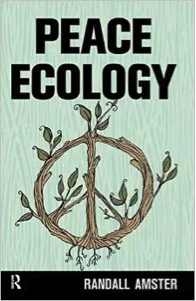Book Review: Peace Ecology by Randall Amster
 Studnicka JSE Nov 2015 Hope Issue PDF
Studnicka JSE Nov 2015 Hope Issue PDF
Abstract: Renowned author and professor Randall Amster embraces peace ecology as a way to engage in cooperative actions and practices that build community and foster resilience. Peace Ecology bridges the gap between social and environmental sciences, highlighting important ethical and interdisciplinary aspects of the field of peace studies and showing how these relate to both human communities and the places in which they are embedded.
Amster, R. (2015). Peace ecology. New York: Routledge.
Keywords: peace ecology, sustainability, social justice
Book Review: Peace Ecology by Randall Amster
Peace Ecology offers a powerful vision of a more peaceful and sustainable world interwoven with straightforward discussions on acute subjects such as war, the disappearance of the commons, the rise of poverty, food and safety concerns, resource conflicts, and environmental obliteration while focusing the reader’s attention on accessible opportunities to peacefully engage in cooperative actions and practices that build community and foster resilience. Amster’s integrative view on issues of peace and ecology superbly connects problems and opportunities together as forces propelling us toward a sustainable future. This book goes beyond expanding on thoughts of social and deep ecology to suggest that humans are naturally prone to cooperate rather than compete. The central image of an intricate thread of cooperation and interconnectedness that exists within and across human communities is woven throughout, suggesting that peacemaking is necessary in order to regain a healthy planet. Amster offers a number of sensible and attainable approaches to reclaiming access to life’s essentials such as healthy food, water, and education, suggesting “peace ecology as viable alternative to the war economy” (p. 9).
Peace Ecology is filled with progressive and practical ideas about peace and peacemaking. It also offers a realistic look at war, highlighting the patterns of its environmental destruction and focusing on the much needed paradigm shift toward choosing peace and sustainability rather than exploitation and destruction. Amster focuses on potential pathways to structural peace through active engagement in re-establishing local commons and community-based food systems and through learning how to be collectively pro-active instead of reactive. These perspectives present significant opportunities for constructive peace building and sustainable living.
The central idea of Peace Ecology is interrelatedness. Amster embraces the multifaceted and holistic nature of peace studies with its complex multi- and interdependencies. He bridges the gap between social and environmental sciences, highlighting important ethical and interdisciplinary aspects of the field of peace studies and showing how these relate to both human communities and the places in which they are embedded. Amster discusses opportunities for people to redirect their mindset and their efforts toward sustainability in ways that resist corporate forces imposed on them. He provides inspirational examples of resilience and local activism of people who chose paths of place-centered cooperation. Amster also examines the role that an interconnected, global environmental view can play in building cooperation and resisting conflict and war that destroy both people and place.
Peace Ecology is organized into eight chapters exploring the subjects of war, conflict, the war economy, the concept of peace and its many interrelated dimensions, the commons, food justice, community resilience and activism, the notion of abundance, hope, progressive approaches to sustenance, and restabilizing communities and their habitats. What I find most appealing and groundbreaking about Peace Ecology is Amster’s brilliant ability to realistically address complex issues of peace and conflict in an integrative manner, leaving his readers with hope and solution-oriented ideas for a more sustainable tomorrow.
I enthusiastically recommended Peace Ecology to all who are diligently striving for peace in their communities and themselves, to those interested in healing approaches to fostering communities of place, and to those interested in holistic visions and approaches for a more sustainable world. As Amster concludes, “The truly remarkable aspect of this vision is that we truly posses all of the tools to manifest it. Nothing referenced here is reliant upon some future technological breakthrough or miraculous recovery. We can make the transition to a more peaceful, just, balanced, and sustainable world with far less effort and commitment of resources than it takes to maintain the current one—the one that is consuming everything (including us) on the way to its predestined demise” (p. 189).
Randall Amster, JD, Ph.D. is director of the Program on justice and Peace at Georgetown University, and serves as executive Director of the Peace and Justice Studies Association. His articles have appeared in journals including Peace Review, Contemporary Justice Review, and the Journal of Sustainability Education, and he has been a regular contributor to online publications including Common Dreams, Huffington Post, and Truthout. Among his works in the field of peace studies are the co-edited volumes Building Cultures of Peace: Transdisciplinary Voices of Hope and Action (2009) and Exploring the Power of Nonviolence: Peace, Politics, and Practice (2013).
Amster, R. (2015). Peace ecology. New York: Routledge.










 Lenka Studnicka is an accomplished educator and an award-winning designer. Lenka is completing her Ph.D. in Sustainability Education with an academic focus on peace education in early childhood contemplated as a sustainable peace building process, which is supported by her international doctoral research. Lenka lives in the small high desert town of Prescott, Arizona.
Lenka Studnicka is an accomplished educator and an award-winning designer. Lenka is completing her Ph.D. in Sustainability Education with an academic focus on peace education in early childhood contemplated as a sustainable peace building process, which is supported by her international doctoral research. Lenka lives in the small high desert town of Prescott, Arizona. 
